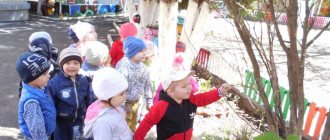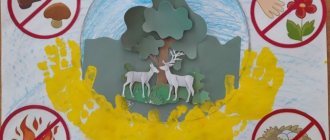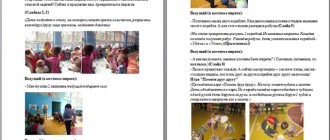Goals and objectives of environmental education
Forming a respectful attitude towards nature is the goal of such education. Having achieved it, the child will learn from an early age:
- rational use of natural resources;
- take care of their preservation;
- study, protect nature.
To achieve this goal, 3 tasks are set:
- Educational. Provides knowledge about modern environmental problems and teaches how to solve them.
- Educational. Instills the habits and needs of a healthy lifestyle and correct behavior in relation to nature.
- Developmental. Teaches in practice how to assess the state of the environment and improve the situation.
The result is the education of a new generation of ecologically cultured people.
Skill of the future: why it is important to talk with children about ecology
Children are our future, so our tomorrow depends on what we tell them today. We talked about the importance of environmental education with Anna Gorshkova, coordinator of the Ekoclass.rf portal.
Why is it important to engage in environmental education for children?
It is obvious that today man influences nature so much that it simply does not have time to cope with it. But our well-being also depends on the health and well-being of nature, since we use all its benefits and resources. And it is obvious that having a healthy and comfortable environment is, first of all, a necessity for ourselves.
It is necessary to tell children about this from an early age, because such knowledge, view of the world, thinking and habits are formed in preschool age. The child is more open and receptive, it is easier for him to try something new, to build, among other things, ecological thinking.
In addition, children are the future of our world: politicians, teachers, ordinary people. What kind of thinking and views we help them form in childhood determines what our world will be like.
Ecological thinking is the skill of seeing relationships in nature, seeing how our actions affect the environment, feeling responsible for today and for the future. In the next 5–10 years, this attitude will be vital in all areas of human life, in any company, in any position. And in every profession, environmental thinking will become one of the basic skills, so it should be instilled from childhood.
Where to start with environmental education of children?
I would advise you to observe what the child is interested in and try to approach it from that direction. As a child, I was interested in animals and nature, which is why I grew up as an ecologist.
Someone might be interested in economics—you can talk about ecological economics.
I also recommend that parents raise their children by example, because they subconsciously repeat the actions of adults. Any eco-habits that can be practiced at home (not using plastic bags or turning off the water and lights) must first be introduced into your life. So, it will not seem complicated to the child.
And, of course, I would start by explaining and demonstrating how diverse, beautiful and unique the world around is. Show why it is worth saving. Show me how amazing everything is! After all, you can watch films and read books on this topic.
How to apply the acquired knowledge in practice?
I repeat, introduce eco-habits. For example, you and your child learned that plastic is bad. Now it is important to move from theory to practice. The easiest way is to start sorting waste, using reusable things, so that there is a connection: there is a problem - I can influence it.
What tips can you give for raising children of different ages?
Very roughly, we divide children into three large age groups:
Children under 7 years old. The influence of parents plays a big role here. By personal example it is worth showing the right habits, helping, giving the opportunity to study, be more in nature, and see what is happening in the world. You can add an interactive format and turn everything into a game.
Children 7-14 years old. At this age, children begin to read actively, you can take advantage of this and give them thematic books. Plus, there are many different cartoons and films on the topic of ecology for children. In elementary school, many are asked to make their own project, so suggest doing it specifically on an environmental theme.
Children from 14 years old. At this age, you can participate in projects on a more serious level: how to make school more environmentally friendly, change your eco-habits. You can volunteer or intern to participate in youth conferences and movements. This is a good experience and sometimes even career guidance. It is possible to take class trips to protected areas, a biological station, or visit biocircles. The main thing is to try to be active at any age.
Environmental education of junior schoolchildren
In elementary school, children are introduced to the world around them and given examples of problems in nature that come from human activity. According to psychologists, it is necessary to increase interest in nature and environmental problems in modern society by working in three areas:
- To develop the child’s emotional qualities: a sense of delight, surprise, empathy, positive feelings towards natural objects, correct behavior.
- Create conditions for the implementation of accumulated knowledge. Provide opportunities to demonstrate environmental awareness in extracurricular activities.
- Provide age-appropriate knowledge.
All components act interconnectedly with an integrated approach. A child's interests and beliefs have not been formed in elementary school. The teacher’s task is to develop eco-culture, teach students to bear responsibility for all life on the planet, and take care of the environment.
Why is environmental education needed?
The relevance of environmental education and enlightenment is determined by the global environmental challenges facing humanity and our country. It should be continuous from preschool age and continue throughout life. Environmental knowledge is necessary for every person to be aware of the consequences of their actions for nature and to understand how to reduce the negative impact on the environment. Environmental education and awareness should include not only theoretical knowledge, but also practical skills: how to save various natural resources (water, energy, etc.), how to properly manage waste, and much more.
The importance of environmental education and enlightenment is constantly declared by the Russian state. In Art. 71 of Federal Law No. 7-FZ “On Environmental Protection” talks about “establishing a system of universal and comprehensive environmental education” in order to “form an environmental culture and professional training of specialists in the field of environmental protection.” In Art. 74 defines the need for general environmental education of the population, in which all levels of government, local governments, and the media should participate.
In the “Fundamentals of State Policy in the Field of Environmental Development of the Russian Federation for the Period until 2030,” approved by the President in 2012, the formation of an environmental culture and the development of environmental education and upbringing are cited as one of the main tasks for achieving the strategic goal of state policy in the field of environmental development. The fundamentals of environmental knowledge are included in the federal state standards of basic general education.
However, there are big problems with the practical implementation of this concept: the level of environmental education and awareness does not correspond to the seriousness of environmental problems. This is due to the lack of a unified state policy in this area and low demand from society and low environmental culture. Economic interests, unfortunately, often prevail over environmental ones, and the concept of a “green” economy still remains only a declaration.
At school, environmental education and enlightenment often rests on the enthusiasm of individual teachers and teachers. At the same time, many environmental education initiatives are implemented by non-profit organizations and civil initiatives. In these conditions, the activities of public organizations become important. With the support of business, NGOs replicate and make environmental education initiatives widespread and create high-quality educational products.
Thus, the ECA movement implements environmental education projects in schools and universities. The educational portal Ekoclass.rf has currently collected 15 all-Russian and international environmental lessons, the purpose of which is to teach schoolchildren to help nature in simple and accessible ways. Lesson topics: separate waste collection, water conservation, environmentally friendly lifestyle, global climate change. 35 thousand teachers are registered on the site, more than 2 million schoolchildren from all regions of Russia and 8 CIS countries took part in the lessons.
The ECA university project is a federal partnership program “Green Universities of Russia”, the objectives of which are the development of “green” administration on the basis of participating universities and the implementation of student environmental initiatives. As part of the program, all-Russian student quests are held, in which more than 20 thousand students from more than 150 Russian universities took part, and the Association of “Green” Universities of Russia was created. This direction is being implemented with the support of The Coca-Cola Foundation (at the initiative of the Coca-Cola system, the “Share with Us” quest is being held in Russia for the second year) and the Federal Target Program “Water of Russia”. As part of the all-Russian quest “Share with Us,” 26 universities have introduced separate waste collection on their bases on an ongoing basis.
What should be emphasized in environmental education and enlightenment in Russia? First of all, it is necessary to convey to schoolchildren and students in a language accessible to them the scale of individual environmental problems, and tell them what ways there are to solve them. It is important not only to convey knowledge, but also to create motivation to influence the problem. And, of course, it is necessary to talk about how today schoolchildren and parents can contribute to the conservation of nature. For example, if we are talking about the problem of waste, then you can teach how to sort waste at home, find recycling collection points in your city, reduce the amount of waste, that is, reveal the practical aspect, encourage action.
In order for environmental education and awareness to become ubiquitous, coordination of all educational structures and environmental departments is needed, and there needs to be a public demand for environmental education and awareness to become a priority. Complex work and cooperation of many parties is important.
Forms of environmental education
Environmental education becomes an important part of the educational process. Teachers work in this direction during lessons and extracurricular activities. Methods and forms of education depend on the age of the child.
Lessons
A popular form is a lesson. Thematic classes are conducted for preschoolers. The subject “Knowledge of the World” has been introduced in primary schools. He introduces children to the world around them and its laws. Classroom activities are divided into 3 types:
- Introductory. They give an idea of different types of plants, animals, and natural phenomena. For better perception, posters, films and other demonstration materials are used.
- Generalizing. They talk about the problems of the planet. Preschoolers of older groups and primary grades learn to separate natural phenomena according to their characteristics.
- Cognitive. Allows you to apply the acquired knowledge in practice. Classes are held in the form of competitions and quizzes.
Lessons lay down theoretical and practical knowledge, taking into account age.
Thematic events
Holidays dedicated to ecology are part of extracurricular activities. Topics are created by teachers or timed to coincide with calendar events (Wildlife Day, Earth Day). The goal is to awaken interest in the problems of nature. The holiday script is drawn up on the basis of previously acquired knowledge.
Hiking and excursions
An effective method of environmental education is direct interaction with living nature. Teachers organize walks in the fresh air or excursions to local history museums.
Starting from the middle groups of kindergartens and middle school classes, participants participate in such events.
Work
In preschool institutions, living corners and flower beds are set up. Children take care of flowers and animals. Schools are holding cleanup days and cleaning classrooms.
The problem of environmental education of preschool children in modern pedagogical theory
The problem of modern environmental education is multifaceted. Today ecology has become a science that should help people survive and make their habitat acceptable for existence. Environmental education is the formation in a person of the ability and desire to act in accordance with the laws of ecology. Currently, environmental education has become an independent field of preschool pedagogical theory and practice. Its novelty, according to L.V. Moiseeva, is manifested “in a change in the approach to introducing children to nature from biological to ecological, in which the pedagogical process is based on the fundamental ideas and concepts of ecology, accessible to preschoolers” [3, p. 5].
According to the definition of N.A. Ryzhova, environmental education of preschool children is “a continuous process of education and development of the child, aimed at forming a system of environmental ideas and knowledge, environmental culture, which manifests itself in an emotionally positive attitude towards nature, in a responsible attitude towards the state of the environment.” environment" [5, p. 7].
M. D. Makhaneva about [2, p. 18].
According to the definition of V. A. Yasvin, environmental education is “a special, purposeful, organized, systematic, consistent, planned pedagogical process of forming a system of environmental knowledge, abilities, skills, views, beliefs, moral qualities, which ensures the formation and development of a responsible person attitude towards nature as a universal value” [8, p. 17].
Environmental education of preschool children is part of the general educational process; it contributes to the development of thinking, speech, erudition, emotional sphere, moral education, that is, the formation of the personality as a whole. In the process of environmental education, preschoolers master the norms of environmentally literate safe behavior based on a set of basic environmental knowledge, awareness of cause-and-effect relationships in nature, and caring attitude towards all living things.
P. G. Fedoseeva believes that the main goal of environmental education in preschool childhood is “the formation of the principles of ecological culture and the formation on this basis in children of a scientific-cognitive, emotional-moral, practical-active attitude towards nature” [6, p. 6]. Love for nature and a caring attitude towards it is ingrained in a child’s soul only if the preschooler sees daily examples of an attentive, caring attitude towards nature on the part of adults, educators and parents.
In the author’s concept of S. N. Nikolaeva, the goal of environmental education of preschoolers is the formation of the principles of ecological culture, which is understood as “the formation of a consciously correct attitude towards nature in all its diversity; to the people who protect it and create material and spiritual values based on nature; to yourself as a part of nature; understanding the value of life and health and their dependence on the state of the environment” [4, p. 21]. The components of the ecological culture of a preschooler’s personality, according to S. N. Nikolaeva, are “knowledge about nature and its ecological orientation, the ability to use it in real life, in various activities (in games, work, in everyday life)” [4, p. thirty].
Among the tasks of environmental education of preschool children S. N. Nikolaeva includes [4, p. 25]:
In the scientific and educational sphere:
— formation of a system of elementary scientific environmental knowledge accessible to the understanding of a preschool child (primarily as a means of developing a conscious attitude towards nature); development of cognitive interest in the natural world;
— formation of skills and abilities to observe natural objects and phenomena.
In the emotional and moral sphere:
— education of a humane, emotionally positive, careful, caring attitude towards the natural world and the environment as a whole; developing a sense of empathy for natural objects;
— formation of an initial system of value orientations (perception of oneself as a part of nature, the relationship between man and nature, the intrinsic value and diversity of meanings of nature, the value of communication with nature);
In the practical and activity sphere:
— formation of initial skills and habits of environmentally literate behavior that is safe for nature and for the child himself;
— mastering basic norms of behavior in relation to nature, developing skills for rational environmental management in everyday life;
— developing the ability and desire to preserve nature and, if necessary, provide assistance to it (care for living objects), as well as skills in basic environmental activities in the immediate environment;
— formation of basic skills to foresee the consequences of some of their actions in relation to the environment [4, p. 26].
The tasks of environmental education of preschool children determine the main directions of this process, the main one of which is the formation of an environmental culture in children.
According to N.A. Ryzhova, the ecological culture of preschool children is characterized by “a certain level of the child’s perception of nature, the world around him and an assessment of his position in relation to nature and the world around him” [5, p. 12]. The assimilation by a preschool child of moral and environmental norms and rules of behavior in nature contributes to the establishment of environmentally correct and safe relationships between the child and the natural environment, the environment of the city, village, village where he lives. Therefore, “when educating the ecological culture of preschoolers, the emotional richness of means and methods that effectively influence the moral and motivational spheres of the child’s personality is especially important” [Ibid., p. 17].
The second direction of environmental education of preschool children is the formation of environmental knowledge and ideas of children based on the selection of educational content. In the case when “ecological knowledge becomes the basis of environmental education and ecological culture of preschool children, the child develops a certain system of values, an idea of man as a part of nature, of the dependence of his life, his health on its condition” [7, p. 36]. In this case, environmental education is closely connected with the development of the child’s emotions, the ability to sympathize, be surprised, empathize, care for living organisms, perceive them as fellow creatures in nature, be able to see the beauty of the surrounding world (and the entire landscape, and an individual flower, a drop of dew, a small spider).
In environmental education of children, the emphasis is mainly on instilling a caring attitude towards nature, developing work skills in natural conditions, nurturing children’s emotional and moral attitude towards natural objects, getting to know a number of animals and plants, and caring for them. All this, of course, plays a big role in the formation of children’s environmentally literate ideas about the environment. However, this is not enough: children need a minimum of environmental knowledge that will help them understand the need to behave environmentally competently.
It should also be noted that many teachers in the learning process draw children’s attention, first of all, to living objects, especially animals; very little attention is paid to objects of inanimate nature. At the same time, it is known that children have a great interest in objects of inanimate nature, and with proper organization of work (conducting experiments, observations), the child easily acquires knowledge about inanimate nature and its connection with living nature.
During the environmental education of preschoolers, mandatory meetings with nature expand children’s understanding, improve their ability to carefully look at various phenomena, and maintain the integrity of perception when creating crafts from natural materials.
When selecting content for children’s environmental education activities in order to form the foundations of children’s environmental culture, it is necessary to take into account the following provisions [1, p. 63]:
— the content of education should be scientific. Despite their age, children should receive scientific ideas about the world around them, in particular about nature, in an accessible form;
— the content of environmental education should contribute to the formation in children of a holistic perception of the world around them, on the one hand, and the interconnections of the parts of this whole, on the other.
Thus, in modern pedagogical theory, the problem of environmental education of preschool children is considered in sufficient detail. Environmental education of preschool children today is a purposeful, organized, systematic, consistent, planned pedagogical process of forming a system of environmental knowledge, skills, attitudes, beliefs, and moral qualities, which ensures the formation and development of an individual’s responsible attitude towards nature as a universal value. The main task of environmental education for preschool children is the education of an ecological culture, within the framework of which the formation of environmental ideas and knowledge in children, the development of positive emotions and feelings towards nature, the development of the perception of nature as a value, the creation of sustainable motivation for activities aimed at protecting, conservation and preservation of the natural habitat, the formation of environmental beliefs based on environmental activities.
Literature:
1. Egorenko L. I. Environmental education of preschoolers and junior schoolchildren / L. I. Egorenko. - M.: Education, 2009. - 126 p.
2. Makhaneva M.D. Ecological development of children of preschool and primary school age: method. manual for preschool teachers and primary school teachers / M. D. Makhaneva. - M.: ARKTI, 2011. - 187 p.
3. Moiseeva L.V. Alternative models of environmental education / L.V. Moiseeva. - Ekaterinburg: UrSPU, 2004. - 156 p.
4. Nikolaeva S. N. Theory and methodology of environmental education for children: a textbook for students. higher ped. textbook institutions / S. N. Nikolaeva. - M.: Academy, 2011. - 336 p.
5. Ryzhova N. A. Environmental education in preschool educational institutions: theory and practice / N. A. Ryzhova. - M.: Karapuz, 2009. - 227 p.
6. Fedoseeva P. G. System of work on environmental education of preschool children. Senior group / P. G. Fedoseeva. - Volgograd: ITD "Corypheus", 2009. - 96 p.
7. Environmental education / Author-comp. N.V. Gorokhovatskaya and others. - St. Petersburg: Publishing House of the Russian State Pedagogical University named after. A. I. Herzen, 2009. - 321 p.
8. Yasvin V. A. Psychology of attitudes towards nature / V. A. Yasvin. - M.: Smysl, 2005. - 186 p.
Methods of environmental education
To better perceive nature-oriented programs, a methodology is being developed for preschool institutions and schools. Teachers use 3 methods in practice.
Visual methods
Include:
- Observation. Children are asked to track the behavior of the animal. Changes in the shape, characteristics, and structure of the plant. In the process, the purpose, timing and method of observation are established.
- Illustrative materials. Literature, images, paintings, posters are a visual way to introduce children to animals, plants and natural phenomena that are inaccessible to observation in their usual environment.
The visual method helps to attract students' attention to environmental issues.
Practical methods
To fully immerse yourself in ecoculture, practical actions are required:
- modeling;
- experiments;
- themed games.
Practice creates a general understanding of natural objects.
Verbal methods
Any method is supported by conversation and reading fiction. Teachers conduct conversations in lessons, before competitions, games, and during experiments.
Environmental education in the family
The relevance of the problem of environmental education is related to the situation within the family. Children are sensitive to their environment. They unwittingly try to imitate adults.
Parents must understand that it is impossible to force a child to certain rules of behavior if they themselves do not comply with them. First of all, you need to cultivate an environmental culture at home.
Joint activities with your child will be beneficial:
- While walking, pay attention to birds and insects. Monitor the weather. Using the verbal method, introduce the child to them.
- Buy colorful literature: encyclopedias, books on caring for animals and plants.
- Get a pet. Explain how to care for it and why it needs to be done.
- Watch documentaries and series about nature.
It is important to reward your child for correct behavior. Mark if he threw the trash in the trash can, fed the fish, or did a good deed.
Ecology
The key component of the concept of “ecology” is “interaction”, “connection”. Initially, since the time of E. Haeckel, who first introduced this term in 1864, and for a long time after that, ecology designated the field of knowledge about the connections of living organisms - plants, animals, their communities - with the environment, i.e. it was a section biology. Later, this concept began to expand to include humans.
At the present stage, ecology can be defined as a science that examines the relationship of living organisms, including humans, and their communities with the environment.
At the same time, the environment can be understood as both the natural environment and the environment as a whole (natural, social, material). In the first case, we talk about ecology in a narrow sense, in the second - in a broad sense.
In environmental education of children, as a rule, they are limited to ecology in the narrow sense, i.e. consider the relationship between man and the natural environment. And this is correct, otherwise the objects to which children’s attitudes are formed become blurred, and there are too many of them. And the environmental problem itself arose precisely because the natural environment began to be destroyed as a result of human activity.
So, the concept of “ecology” includes two components: nature as biological objects, as the natural environment and the connections between them. Consequently, preparing a preschooler for subsequent full mastery of ecology includes:
- a) the formation in children of ideas about objects of environmental interaction - objects of nature, and first of all about plants and animals (and this is natural science);
- b) the formation of ideas about connections, without yet dividing them into natural, environmental or other connections.
The study of relationships (cause and effect) in preschool education is currently receiving the necessary attention, but this is not always connected with environmental education. Whereas in the educational system “School 2100” this area of work is directly tied to it. As the authors of the textbook “Hello, World!” note, they begin environmental education with the idea formulated by ecologist Barry Commoner: “everything is connected to everything” [1]. And this is the beginning of the formation of an appropriate universal educational action, defined in the Federal State Educational Standard for primary education as “identifying cause-and-effect relationships.”
However, there is an aspect in the Federal State Educational Standard for Education that is directly related to environmental education. One of the tasks there is formulated as follows: “development of emotional and value perception... of the natural world.” This task is implemented within the framework of environmental education, since the formation and development of emotional and value relations towards nature belong to the sphere of environmental education. And an emotional-value attitude is possible if children have ideas (knowledge) about nature as something valuable, i.e. elements of environmental education should also be present here.







